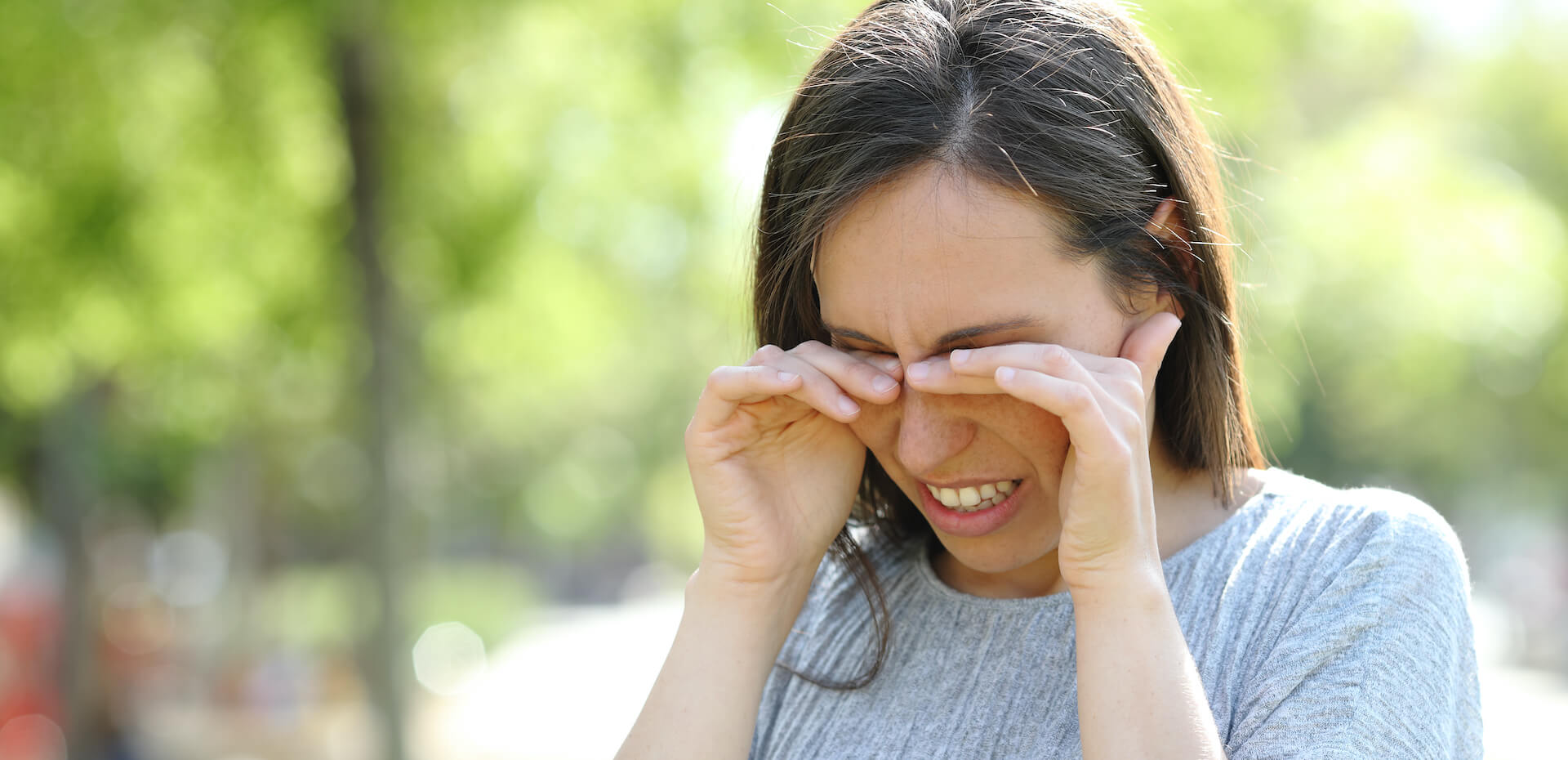Do you have dry, itchy, or irritated eyes? These are some of the signs that go along with a common condition called dry eye syndrome. Patients with dry eye syndrome may also have a chronic disease known as meibomian gland dysfunction (MGD). Many patients with MGD also suffer from dry eye symptoms. To treat MGD and dry eye symptoms Envue offers OptiLight treatment for dry eye, an elevated management of your dry eye. OptiLight uses patented Optimal Pulse Technology for precise, intense broad spectrum light to address inflammation, one of the key underlining factors in dry eye disease, due to meibomian gland dysfunction (MGD).

What are the signs of dry eyes disease?
Many people experience some degree of dry eye symptoms during their lives. Although some signs and symptoms may seem obvious, many people may experience symptoms that don’t seem related to dry eye disease. Common signs and symptoms include:
- Burning sensation
- Itchy eyes
- Aching sensations
- Heavy eyes
- Fatigued eyes
- Sore eyes
- Dryness sensation
- Red eyes
- Photophobia
- Blurred vision
Another common symptom is something called a foreign body sensation — the feeling that grit or some other object or material is “in” your eye. And as odd as it may sound, watery eyes also can be a symptom of dry eye syndrome. This is because dryness on the eye’s surface sometimes will over-stimulate production of the watery component of your tears as a protective mechanism. But this “reflex tearing” does not stay on the eye long enough to correct the underlying dry eye condition. In addition to these symptoms, dry eyes can cause inflammation and (sometimes permanent) damage to the surface of the eye. Treatment options for dry eye include artificial tears, prescription eye drops or steroids, punctal plugs, warm compresses, lifestyle modification and meibomian gland expression procedures such as OptiLight treatment for dry eye. Treatments are tailored by the cause of dry eye and patient goals.
Dry eye syndrome also can affect the outcomes of LASIK and cataract surgery which is why we evaluate and treat patients with dry eye prior to having vision correction surgery at Envue Eye and Laser Center.
What are some common factors associated with dry eye syndrome?
Tears bathe the eye’s surface to keep it moist and wash away dust, debris and microorganisms that could damage the cornea and lead to an eye infection. An adequate and consistent layer of tears on the surface of the eye is essential to keep your eyes healthy, comfortable and seeing well. Common risk factors associated with dry eye disease include:
- Computer use — When working at a computer or using a smartphone or other portable digital device, we tend to blink our eyes less fully and less frequently, which leads to greater tear evaporation and increased risk of dry eye symptoms.
- Contact lens wear — Though it can be difficult to determine the exact extent that contact lens wear contributes to dry eye problems, dry eye discomfort is a primary reason why people discontinue contact lens wear. Vision correction surgery such as SMILE or LASIK is a great alternative to wearing contact lenses.
- Aging — Dry eye syndrome can occur at any age, but it becomes increasingly more common later in life, especially after age 50.
- Menopause — Post-menopausal women are at greater risk of dry eyes than men of the same age.
- Indoor environment — Air conditioning, ceiling fans and forced air heating systems all can decrease indoor humidity and/or hasten tear evaporation, causing dry eye symptoms.
- Outdoor environment — Arid climates and dry or windy conditions increase dry eye risks.
- Frequent flying — The air in the cabins of airplanes is extremely dry and can lead to dry eye problems, especially among frequent flyers.
- Smoking — In addition to dry eyes, smoking has been linked to serious eye problems, including macular degeneration, cataracts and uveitis.
- Health conditions — Certain systemic diseases — such as diabetes, thyroid-associated diseases, lupus, rheumatoid arthritis and Sjogren’s syndrome — contribute to dry eye problems.
- Medications — Many prescription and nonprescription medicines — including antihistamines, antidepressants, certain blood pressure medications and birth control pills — increase the risk of dry eye symptoms.
- Eyelid problems — Incomplete closure of the eyelids when blinking or sleeping — a condition called lagophthalmos, which can be caused by aging or occur after cosmetic blepharoplasty or other causes — can cause severe dry eyes that can lead to a corneal ulcer if left untreated. Floppy eyelid syndrome (FES) has been found to be an independent risk factor for Obstructive Sleep Apnea (OSA). FES results in loose, rubbery eyelids which easily flip over while sleeping thereby exposing the eye.
- CPAP Treatment for Obstructive Sleep Apnea – Obstructed sleep apnea (OSA) is often treated with continuous positive airway pressure therapy (CPAP). A CPAP machine increases the air pressure in the throat so that your airway doesn’t collapse when you breath. Poor fitting CPAP masks can lead to dry eye due to air escaping from the mask and constantly blowing into the eye.
- Surgery– corneal refractive surgery can sometimes be associated with dry eyes. However, in most cases, dry eye discomfort after laser vision correction is temporary and resolves within a few weeks of the procedure.

Dry Eye Treatment at Envue Eye and Laser Center
Dry eye disease can have a number of causes, and a variety of treatment approaches are used. Envue Eye and Laser Center evaluates and diagnoses dry eye disease. Successful treatment of dry eyes requires that you are willing to follow your eye doctor’s recommendations and that you use the products recommended consistently and as frequently as directed. These treatments can range simple artificial tears, prescription eye drops or steroids, punctal plugs, warm compresses, lifestyle modification and meibomian gland expression procedures such as OptiLight treatment for dry eye.
Who benefits ?
Of the 30 million people in the United States that suffer from dry eye syndrome, 86% of them also have signs of meibomian gland dysfunction (MGD). MGD has no cure, but patients can manage the condition and their symptoms with heat and pressure treatments.
MGD is caused by natural abnormalities or blockages in the eyelid glands. There are 25 to 40 of these cavities in the upper eyelid and 20 to 30 in the lower eyelid. They give off oil to coat the eye surface and prevent optical fluids from evaporating. Meibomian gland dysfunction prevents the glands from giving off oil. This causes the liquid on the eyes to evaporate too quickly.
Dry eyes are the most common symptom of MGD. People with the condition often feel as if there is sand or dirt between their eyes and eyelids. They may have blurred vision or red eyes due to their eyes not having enough lubrication.
If you’re 40 years old or older, you have a higher chance of developing MGD. Your chances of developing this condition only increase as you get older. Teens and children have a low probability of having the issue.


Content Reviewed and Approved by Dr. Rivers.
Dr. Bruce Rivers is a military-trained ophthalmologist and one of the foremost experts in the field of laser vision correction surgery. He began his ophthalmology career as an eye technician and medic in the U.S. Navy and later obtained his medical degree from Howard University College of Medicine on an Army scholarship.









